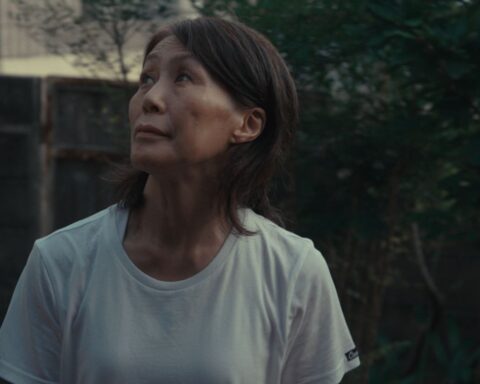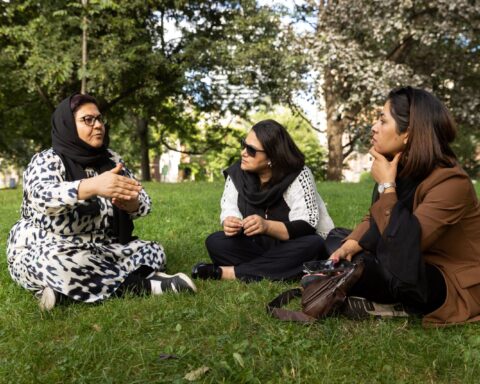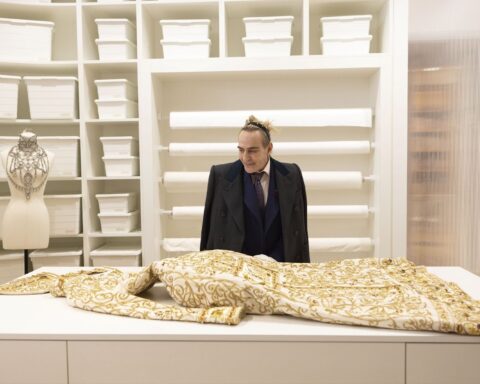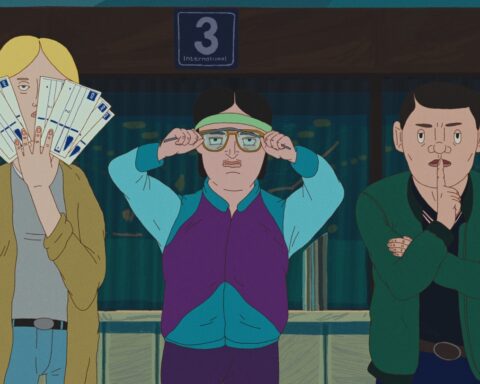The horror of suburbia is not that it is populated by zombies— Dawn of the Dead notwithstanding—but by people, and that the myriad human complexities they bring with them are subsumed and stifled within a design that seeks to banish complexity entirely. What’s truly chilling is that many of the residents within that design are all too aware of these effects, yet feel as if this is the best way of life, and of living, open to them. This fundamental self-awareness of the suburbanite is invoked early on in Radiant City, Gary Burns and Jim Brown’s brisk and entertaining new documentary on the legacy of 20th century suburban sprawl and its consequences for the 21st.
“The most unhelpful idea is that people who move to the suburbs are somehow brainwashed,” says Joseph Heath, co-author of The Rebel Sell. “People who live in suburbia know backwards and forwards the critique of suburbia, yet they still live in suburbs. The fact is that people live in suburbs because they have incentives to do so. And as long as those things are available, people are going to keep buying them.”
One can often forget about these wholly understandable motives when indulging in the traditional sport of suburban mockery. As we listen to James Howard Kunstler, author of The Geography of Nowhere, rail against “Potemkin village shopping plazas,” “Orwellian office parks,” and “the whole agoraphobia-inducing toxic spectacle” of it all, it’s too easy to forget about the individuals encased within these landscapes, to envision the same faceless mass the developers had in mind for their monuments to impersonality. Scorn for suburbia has existed as long as institution itself, producing the same perpetually relevant and endlessly reiterated criticisms, while suburbs grow ever wider and ever more people flock to them. Bridging the barriers to social interaction and healthy complexity erected by suburbs and those who enable them requires that dialogue take place across the chasm, rather than each side reproducing more of the same criticisms and justifications.
It’s that kind of dialogue, however modest, which Burns and Brown hope their film can spark. “Rather than thinking we can change the world, we’re hoping that after seeing the movie people can go off and have a really good one hour conversation over a beer or a coffee,” says Brown. Burns is more optimistic, however cautiously. “We’ve talked before about how there are a hundred books on this subject and nothing anyone says is going to change anything, but whether that’s true or not, I don’t know,” he says. “We’re just basically trying to keep the conversation going, because even if suburban sprawl is a big topic in certain circles, there are a lot of others who are oblivious to it.”
Burns and Brown’s consideration for that latter group is what steers Radiant City clear of dry sermonizing. While academics, authors, architects and experts – including Mark Kingwell, urban designer Ken Greenberg, walkability advocate Bev Sandalack, architecture professor Marc Boutin and town planner Andrés Duany—appear often to detail and contextualize the rise of suburbia and its pernicious effects upon the cultural, economic, ecological, spiritual and aesthetic environment, we also hear from a cross-section of suburban dwellers who speak about their lives with an often surprising candor and clarity.
It’s these people who are our most prominent tour guides through Radiant City, principally the Moss family, residents of a treeless community dubbed, without irony, Evergreen. The children, Nick and Jennifer, lead us through the strange and artificial environment that is meant to nurture their development (Jennifer likes to dance on top of the electrical box in their front yard); mother Anne takes us through her house but pauses at the bedroom, confessing her nervousness and opining that she “doesn’t know how silly you’re going to make me look”; father Evan takes us on his daily commute to work and, while professing complete satisfaction with his surroundings and situation, inadvertently lets slip the many cracks and worries he and his family harbour in the strange new world. To a great extent, our discoveries replicate the ones that the Mosses make and have made about themselves, even while steeped in this supposed bastion of self-delusion.
While there is certainly humour (intentional or not) in some of the Mosses’ utterances, there is no trace of condescension on the part of the filmmakers. “Even though this is a very strong point of view film,” says Burns, “we tried to allow these people to speak for themselves, rather than feel like they were being preached at.” That very strong point of view, of course, is what makes Radiant City the exhilarating cinematic experience that it reaches at its peak. With his prize-winning 2000 breakthrough film waydowntown, Burns took the everyday surrealism of the urban experience and catapulted it into outright fantasy, which could still never quite take leave of the grim reality, which sparked it in the first place. When he participated in a radio roundtable on suburban sprawl which Brown, a veteran CBC journalist, conducted for The Current, the idea of a filmic collaboration began taking shape.
“At first, the idea was to make it more Calgary specific,” recalls Brown. “But we soon decided that these places shouldn’t be just anywhere, they should be everywhere.” To that end, Burns and Brown, along with longtime Burns DOP Patrick McLaughlin, devised the film’s distinctive visual scheme, replete with eerily perfect compositions, allowing the material to bend and skew into darker and more troubled places (the film’s working title, appropriately, was Perfect). “The first idea we had was that each suburb we showed should look like a commercial for that subdivision,” says Brown. “So we took great pains to make the sky look beautifully blue, the clouds puffy white, the lawns bright green…you know that creepy Claritin commercial? That’s the kind of look we were going for. We wanted to shoot every day in bright sunlight, and to always see a couple across the street taking their Golden Lab for a walk.”
This emphasis upon suburban “perfection,” the surrealism within the hyperreal, is not simply a snarky gesture on the filmmakers’ part, but an intrinsic element of their design. That couple walking the Golden Lab does turn up everywhere in the film, and is one of the subtle clues that Burns and Brown are not simply stitching together a series of interviews. “We had two ideas when we started working on this film,” says Burns. “The first was that we wanted to make a documentary on suburban sprawl. Now, that’s an important topic, but it can also strike some people as dry. So our second aim was to play with the documentary form itself, to shake it up and show that it’s not quite as pure as people believe.”
The impurities in these seemingly placid suburban waters become ever more discernible the more time we spend with the Moss family, whose ruptures are not limited to the plain evidence of a rather fraying marriage. While every word that comes out of their mouths rings (sometimes frighteningly) true, there are moments therein—little glitches, moments that seem a little too “perfect”—which indicate that there is another level of operation somewhere within the film. Burns and Brown are coy on this point, but their skirting hints are also revealing of many of the core assumptions of the documentary aesthetic. “We found the interior of the Moss home to be really malleable,” notes Brown. “I mean, it could have been three or four different houses and nobody would be the wiser. All these places are essentially the same. We even thought about maybe having the family dog change breeds from shot to shot, and wondered whether anybody would notice.” Burns picks up from this whimsical suggestion to tie it to the normative signs of “reality” present in all variety of media. “If you’re telling a true story about yourself but perhaps you’re not standing in your own kitchen, how different is that from interviewing an executive for a news story and he says, ‘Let’s move to a different office, it has a better view’?”
The views that Burns and Brown provide of their subject, meanwhile, are simultaneously beautiful and horrifying. Even while exploiting to the fullest the peculiarly cinematic qualities of these archetypically arid modern spaces, Radiant City is no ironic paean to suburbia: Burns and Brown are looking to bury the sprawling monster, not praise it. “Both Gary and I grew up in the suburbs, but these new suburbs are nothing like the ones we knew,” says Brown. “They really do feel surreal. We were shooting test footage in the middle of the day with a full crew, and I swear, you’re never in a place that’s completely silent, but this place was silent: everybody was at work, there was nobody on the streets, there weren’t even any birds because there were no trees. I’ve never been in a place other than a sound studio which was that quiet. So one of our initiatives was to introduce these new spaces to people who haven’t been there, and to show what they signify for our culture.”
On that point, Brown firmly situates himself in the more pessimistic view espoused by Greenberg, despite Duany’s cheery explications of the “new urbanism” gaining traction among urban planners. “My feeling is that the momentum to build these places is so huge that some kind of catastrophe will be required to end it. New philosophies and concepts will have an impact in one or two communities, but three-dozen new suburban communities will counterbalance every one of those. Frankly, I think it’ll only end when we either run out of fuel or the cost of fuel becomes so high that these communities are no longer livable.”
“It takes so much political will just to conceive of creating any other type of community,” concurs Burns. “The fact is, most people don’t have a choice as to where they live, because they’re inundated with this idea that you’ve got to have a backyard and a front lawn and a big house, because that’s what TV tells you (that) you need to have. And that’s going to continue until the city government says, ‘no, you’re not going to build like this anymore.’” As if that’s not an enormous enough obstacle, Brown adds, “to build walkable communities you have to break every by-law and fight every step of the way. If you want narrow streets, it’s against the rules; if you want apartments above stores, it’s against the rules. By- laws are written to virtually guarantee the spread of suburban sprawl monoculture.”
For all that, however, the filmmakers concede that the dialogue about suburban sprawl is now beginning to crop up in surprising places, most notably from the mouth of the mayor of Calgary, “the very picture of the suburban dad,” as Brown caustically notes. “This is a mayor whose election campaign was funded by developers, and yet now he’s talking about walkable communities, stopping sprawl, condensifying, living and working in the same area. Whether he’s sincere or not, he certainly talks a good game. You wouldn’t have been hearing this kind of talk from a politician fifteen or twenty years ago.” Nor might one expect the balance, depth, and refreshing lightness which Radiant City evinces in a left-leaning documentary culture, which has increasingly privileged the bite- sized, shallow and shrill qualities it purports to rail against. Co-existing with the audience-friendly flamboyance, which one can only expect from talented filmmakers, Burns and Brown present plainly and simply the realities of suburban monoculture without preaching either to the choir or the unconverted. Radiant City surpasses its patently ironic title to show the clarity which is the forerunner of hope within a seemingly intractable situation, and the hope that can lead, however haltingly, to change.








